All settings: Casio G-Shock 3195 Digital Watch User Guide

Content

Introduction of Casio G-Shock 3195 Digital Watch
The G-Shock 3195 Digital Watch is a rugged and durable timepiece designed for those who lead an active lifestyle. This watch is perfect for outdoor enthusiasts, athletes, and anyone who needs a watch that can withstand the elements. The estimated price of the Casio G-Shock Digital Watch is around $150, and it is now available for purchase.
Detailed Specifications
The Casio G-Shock 3195 Digital Watch features a 51.9mm resin case and a mineral dial window, providing excellent durability and scratch resistance. The watch is powered by a Japanese quartz movement and is equipped with a digital display. The watch is also shock-resistant, and water-resistant up to 200 meters, and features a stopwatch, countdown timer, and multiple alarms. The watch also has a world time function, allowing you to easily keep track of time in different time zones.
Description of G-Shock 3195 Digital Watch
The Casio G-Shock Digital Watch is a reliable and accurate timepiece that is built to last. The watch's shock-resistant design ensures that it can withstand even the toughest conditions, while its water-resistance rating of 200 meters makes it suitable for use during water sports and other aquatic activities. The watch's digital display is easy to read, and the watch's various functions, such as the stopwatch, countdown timer, and multiple alarms, make it a versatile tool for everyday use. The watch's world time function is also a useful feature for travelers, allowing them to keep track of time in different time zones with ease.
Setup of Casio Digital Watch
To operate the Casio G-Shock Digital Watch, simply press the button on the right side of the watch to cycle through the different functions. To set the time, press and hold the button on the bottom right corner of the watch until the hour digit starts flashing. Use the other buttons to adjust the hour, minute, and AM/PM settings. To set the alarms, press the button on the top right corner of the watch until the alarm icon starts flashing. Use the other buttons to adjust the alarm time and activate or deactivate the alarm. To use the stopwatch or countdown timer, press the button on the bottom left corner of the watch. The watch also features a backlight, which can be activated by pressing the button on the top left corner of the watch.
General Guide
- Press C to change from mode to mode.
- In any mode (except when a setting screen is on the display), press L to illuminate the display.

Radio-controlled Atomic Timekeeping
This watch receives a time calibration signal and updates its time setting accordingly.
This watch is designed to pick up the time calibration signals transmitted in Germany (Mainflingen), England (Anthorn), the United States (Fort Collins), China (Shangqiu), and Japan (Fukushima, Fukuoka/Saga).
Current Time Setting
- This watch adjusts its time setting automatically in accordance with a time calibration signal. You also can perform a manual procedure to set the time and date, when necessary.
- The first thing you should do after purchasing this watch is to specify your Home City (the city where you normally will use the watch). For more information, see “To specify your Home City” below.
- When using the watch outside the areas covered by the time signal transmitters, you will have to adjust the current time setting manually as required. See “Timekeeping” for more information about manual time settings.
- The U.S. time calibration signal can be picked up by the watch while in North America. The term “North America” in this manual refers to the area that consists of Canada, the continental United States, and Mexico.
- As of January 2009, China does not use Daylight Saving Time (DST). If China does go to the Daylight Saving Time system in the future, some functions of this watch may no longer operate correctly.
To specify your Home City
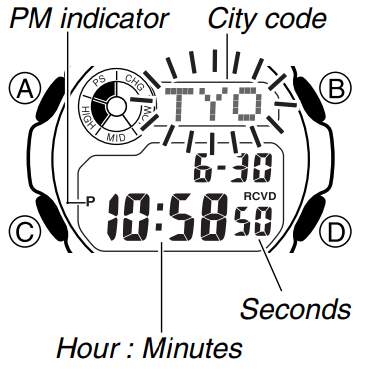
- In the Timekeeping Mode, hold down A until the city code starts to flash, which indicates the setting screen.
- Press D (east) and B (west) to select the city code you want to use as your Home City.
- LIS, LON : Lisbon, London
- MAD, PAR, ROM, BER, STO : Madrid, Paris, Rome, Berlin, Stockholm
- ATH : Athens
- MOW : Moscow
- HKG, BJS, TPE : Hong Kong, Beijing, Taipei
- SEL, TYO : Seoul, Tokyo
- HNL : Honolulu
- ANC : Anchorage
- YVR, LAX : Vancouver, Los Angeles
- YEA, DEN: Edmonton, Denver
- MEX, CHI : Mexico City, Chicago
- NYC : New York
- YHZ : Halifax
- YYT : St.Johns
- Press A to exit the setting screen.
- Normally, your watch should show the correct time as soon as you select your Home City code. If it does not, it should adjust automatically after the next auto receive operation (in the middle of the night). You also can perform manual receive or you can set the time manually.
- The watch will receive the time calibration signal automatically from the applicable transmitter (in the middle of the night) and update its settings accordingly. For information about the relationship between city codes and transmitters, see “Time Calibration Signal Reception” and “Transmitters”.
- See the maps under “Approximate Reception Ranges” for information about the reception ranges of the watch.
- You can disable time signal reception, if you want. See “To turn auto receive on and off” for more information.
- Under factory default settings, auto receive is turned off for all of the following city codes: MOW (Moscow), HNL (Honolulu), and ANC (Anchorage). For details about turning on auto receive for these city codes, see “To turn auto receive on and off”.
Time Calibration Signal Reception
There are two different methods you can use to receive the time calibration signal: auto-receive and manual receive.
- Auto Receive
With auto receive, the watch receives the time calibration signal automatically up to six times a day (five times a day for the Chinese calibration signal). When any auto receive is successful, the remaining auto receive operations are not performed. For more information, see “About Auto Receive”. - Manual Receive
Manual receive lets you start a time calibration receive operation with the press of a button. For more information, see “To perform manual receive”.
Important! When getting ready to receive the time calibration signal, position the watch as shown in the nearby illustration, with its 12 o’clock side pointing towards a window. This watch is designed to receive a time calibration signal late at night. Because of this, you should place the watch near a window as shown in the illustration when you take it off at night. Make sure there are no metal objects nearby.
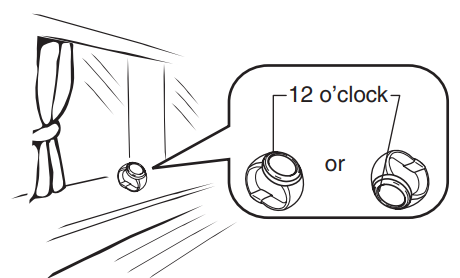
- Make sure the watch is facing the right way.
Proper signal reception can be difficult or even impossible under the conditions listed below.
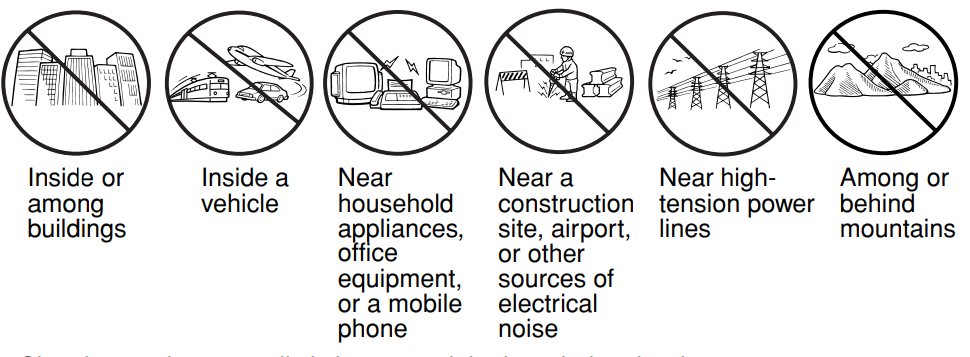
- Signal reception normally is better at night than during the day.
- Time calibration signal reception takes from two to seven minutes, but in some cases it can take as long as 14 minutes. Take care that you do not perform any button operations or move the watch during this time.
The time calibration signal the watch will attempt to pick up depends on its current Home City code setting as shown below
Home City Code Transmitter Frequency LIS, LON, MAD, PAR, ROM, Anthorn (England) 60.0 kHz BER, STO, ATH, MOW* HKG, BJS Shangqiu City (China) 68.5 kHz TPE, SEL, TYO Fukushima (Japan) 40.0 kHz Fukuoka/Saga (Japan) 60.0 kHz HNL*, ANC*, YVR, LAX, YEA, Fort Collins, Colorado 60.0 kHz DEN, MEX, CHI, NYC, YHZ, YYT (the United States) - The areas covered by the HNL, ANC, and MOW city codes are quite far from the time calibration signal transmitters, and so certain conditions may cause problems with signal reception.
- Calibration signal reception is disabled while a countdown timer operation is in progress
Approximate Reception Ranges
U.K. and German Signals


- Signal reception may not be possible at the distances noted below during certain times of the year or day. Radio interference also may cause problems with reception. Mainflingen (Germany) or Anthorn (England) transmitters: 500 kilometers (310 miles) Fort Collins (United States) transmitter: 600 miles (1,000 kilometers) Fukushima or Fukuoka/Saga (Japan) transmitters: 500 kilometers (310 miles) Shangqiu (China) transmitter: 1,500 kilometers (910 miles)
- Even when the watch is within the reception range of the transmitter, signal reception will be impossible if the signal is blocked by mountains or other geological formations between the watch and signal source.
- Signal reception is affected by weather, atmospheric conditions, and seasonal changes.
- See the information under “Signal Reception Troubleshooting” if you experience problems with time calibration signal reception.
About Auto Receive
The watch receives the time calibration signal automatically up to six times a day (five times a day for the Chinese calibration signal). When any auto receive is successful, the remaining auto receive operations are not performed. The reception schedule (calibration times) depends on your currently selected Home City, and whether standard time or Daylight Saving Time is selected for your Home City.
| Your Home City | Standard Time | Daylight Saving Time | 1 | 2 | 3 | 4 | 5 | 6 |
|---|---|---|---|---|---|---|---|---|
| LIS | 1:00 am | 2:00 am | 3:00 am | 4:00 am | 5:00 am | Midnight* | ||
| LON | 2:00 am | 3:00 am | 4:00 am | 5:00 am | Midnight* | 1:00 am* | ||
| MAD | 2:00 am | 3:00 am | 4:00 am | 5:00 am | Midnight* | 1:00 am* | ||
| PAR | 3:00 am | 4:00 am | 5:00 am | Midnight* | 1:00 am* | 2:00 am* | ||
| ROM | 3:00 am | 4:00 am | 5:00 am | Midnight* | 1:00 am* | 2:00 am* | ||
| BER | 3:00 am | 4:00 am | 5:00 am | Midnight* | 1:00 am* | 2:00 am* | ||
| STO | 3:00 am | 4:00 am | 5:00 am | Midnight* | 1:00 am* | 2:00 am* | ||
| ATH | 3:00 am | 4:00 am | 5:00 am | Midnight* | 1:00 am* | 2:00 am* | ||
| MOW | 4:00 am | 5:00 am | Midnight* | 1:00 am* | 2:00 am* | 3:00 am* |
| Your Home City | Auto Receive Start Times | 1 | 2 | 3 | 4 | 5 | 6 |
|---|---|---|---|---|---|---|---|
| HKG | Standard Time and | 1:00 am | 2:00 am | 3:00 am | 4:00 am | 5:00 am | |
| BJS | Daylight Saving Time | ||||||
| TPE | Standard Time | Midnight | 1:00 am | 2:00 am | 3:00 am | 4:00 am | 5:00 am |
| SEL | |||||||
| TYO | |||||||
| HNL | Standard Time and | Midnight | 1:00 am | 2:00 am | 3:00 am | 4:00 am | 5:00 am |
| ANC | Daylight Saving Time | ||||||
| YVR | |||||||
| LAX | |||||||
| YEA | |||||||
| DEN | |||||||
| MEX | |||||||
| CHI | |||||||
| NYC | |||||||
| YHZ | |||||||
| YYT |
Note
- When a calibration time is reached, the watch will receive the calibration signal only if it is in either the Timekeeping Mode or World Time Mode. Reception is not performed if a calibration time is reached while you are configuring settings.
- Auto receive of the calibration signal is designed to be performed early in the morning, while you sleep (provided that the Timekeeping Mode time is set correctly). Before going to bed for the night, remove the watch from your wrist, and put it in a location where it can receive the signal easily.
- The watch receives the calibration signal for two to seven minutes everyday when the time in the Timekeeping Mode reaches a calibration time. Do not perform any button operation within seven minutes before or after the calibration times. Doing so can interfere with correct calibration.
- Remember that reception of the calibration signal depends on the current time in the Timekeeping Mode. The receive operation will be performed whenever the display shows any one of the calibration times, regardless of whether or not the displayed time actually is the correct time.
About the Signal Strength Indicator
The signal strength indicator shows the strength of the calibration signal being received. For best reception, be sure to keep the watch in a location where signal strength is strongest. The signal strength indicator is displayed while an auto or manual receive operation is in progress
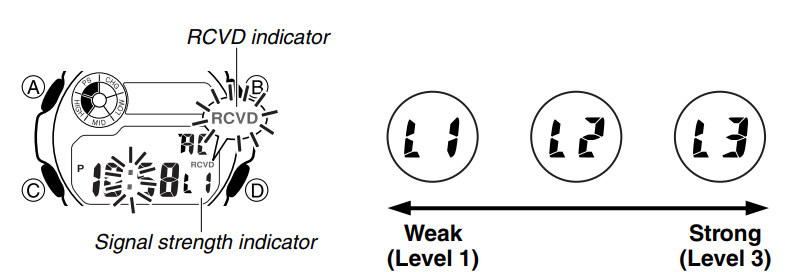
- Even in an area where signal strength is strong, it takes about 10 seconds for signal reception to stabilize enough for the signal strength indicator to indicate signal strength.
- Use the signal strength indicator as a guide for checking signal strength and for finding the best location for the watch during signal receive operations
- Following reception of the time calibration signal and calibration of the watch’s time setting, the RCVD indicator will remain on the display in all modes. The RCVD indicator will not be displayed if signal reception was unsuccessful or after you adjust the current time setting manually.
- The RCVD indicator is displayed only when the watch is able to receive both time and date data successfully. It does not appear when only time data is received.
- The RCVD indicator indicates that at least one of the auto calibration signal receive operations was successful. Note, however, that the RCVD indicator disappears from the display each day when the first auto receive operation of the day is performed.
To perform manual receive

- Enter the Timekeeping Mode.
- Hold down D for about two seconds until the RCVD indicator starts to flash on the display. This indicates that manual receive is in progress.
- Time calibration signal reception takes from two to seven minutes. Take care that you do not perform any button operations or move the watch during this time.
- If the receive operation is successful, the reception date and time appear on the display, along with the GET indicator.
- After manual receive is complete, press D to return to normal timekeeping.
- The watch also will return to normal timekeeping if you do not perform any button operation for about one or two minutes.
- If the latest reception fails but a previous reception was successful, the RCVD indicator will be on the display.
- Note: To interrupt a receive operation and return to normal timekeeping, press D.
To turn auto receive on and off
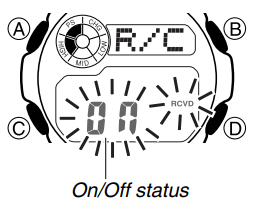
- In the Timekeeping Mode, press D to display the last successful receive time and date screen.
- Hold down A until the current auto receive setting (ON or OFF) starts to flash. This is the setting screen.
Note that the setting screen will not appear if the currently selected Home City is one that does not support time calibration reception. - Press D to toggle auto receive on (ON) and off (OFF). 4. Press A to exit the setting screen.
For information about city codes that support signal receive, see “To specify your Home City”
To check the latest signal reception results
In the Timekeeping Mode, press D to view the last successful receive time and date. Press D again to return to the previous screen
The watch also will return to normal timekeeping if you do not perform any button operation for about one or two minutes.

World Time

World Time shows the current time in 48 cities (31 time zones) around the world
- The times kept in the World Time Mode are synchronized with the time being kept in the Timekeeping Mode. If you feel that there is an error in any World Time Mode time, check to make sure you have the correct city selected as your Home City. Also check to make sure that the current time as shown in the Timekeeping Mode is correct.
- Select a city code in the World Time Mode to display the current time in any particular time zone around the globe. See the “City Code Table” for information about the UTC differential settings that are supported
- All of the operations in this section are performed in the World Time Mode, which you enter by pressing C.
To view the time in another city
While in the World Time Mode, use D (eastward) and B (westward) to scroll through the city codes (time zones).
Pressing D and B at the same time will jump to the UTC time zone.
To toggle a city code time between Standard Time and Daylight Saving Time

- In the World Time Mode, use D and B to display the city code (time zone) whose Standard Time/Daylight Saving Time setting you want to change.
- Hold down A to toggle between Daylight Saving Time (DST indicator displayed) and Standard Time (DST indicator not displayed).
- The DST indicator is shown on the World Time Mode screen while Daylight Saving Time is turned on.
- Note that the Standard Time/Daylight Saving Time setting affects only the currently displayed city code. Other city codes are not affected.
- Note that you cannot switch between Standard Time and Daylight Saving Time while UTC is selected as the city code.
Alarms
The Alarm Mode gives you a choice of four one-time alarms and one snooze alarm. Also use the Alarm Mode to turn the Hourly Time Signal (SIG) on and off.
- There are five alarm screens numbered AL1, AL2,AL3 and AL4 for the one-time alarm, and a snooze alarm screen indicated by SNZ. The Hourly Time Signal screen is indicated by SIG.
- All of the operations in this section are performed in the Alarm Mode, which you enter by pressing C.
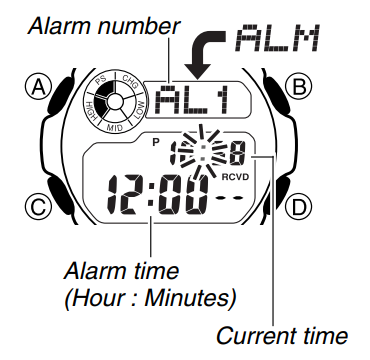
To set an alarm time
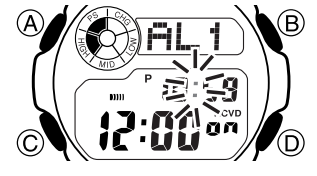
In the Alarm Mode, use D to scroll through the alarm screens until the one whose time you want to set is displayed.

- To set a one-time alarm, display alarm screen AL1, AL2, AL3 or AL4. To set the snooze alarm, display the SNZ screen.
- The snooze alarm repeats every five minutes.
- After you select an alarm, hold down A until the hour setting of the alarm time starts to flash, which indicates the setting screen.
- This operation turns on the alarm automatically.
- Press C to move the flashing between the hour and minute settings.
- While a setting is flashing, use D (+) and B (–) to change it.
- With the 12-hour format, set the time correctly as a.m. or p.m. (P indicator).
- Press A to exit the setting screen.
Alarm Operation
The alarm tone sounds at the preset time for 10 seconds, regardless of the mode the watch is in. In the case of the snooze alarm, the alarm operation is performed a total of seven times, every five minutes, until you turn the alarm off.
- Alarm and Hourly Time Signal operations are performed in accordance with the Timekeeping Mode time.
- To stop the alarm tone after it starts to sound, press any button.
- Performing any one of the operations below during a 5-minute interval between snooze alarms cancels the current snooze alarm operation
- Displaying the Timekeeping Mode setting screen
- Displaying the SNZ setting screen
To test the alarm
In the Alarm Mode, hold down D to sound the alarm.
To turn an alarm on and off
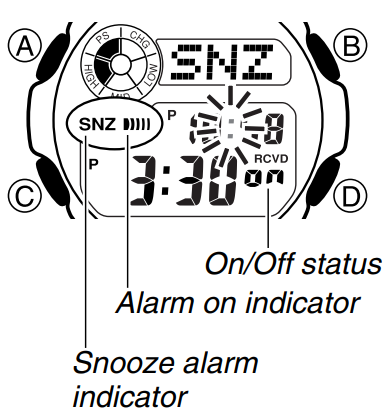
- In the Alarm Mode, use D to select an alarm.
- Press B to toggle it on ( ) and off (xx)
- Turning on a alarm (AL1, AL2, AL3, AL4 or SNZ) displays the alarm on indicator on its Alarm Mode screen.
- In all modes, the alarm on indicator is shown for any alarm that currently is turned on.
- The alarm on indicator flashes while the alarm is sounding.
- The snooze alarm indicator flashes while the snooze alarm is sounding and during the 5-minute intervals between alarms.
To turn the Hourly Time Signal on and off

- In the Alarm Mode, use D to select the Hourly Time Signal (SIG).
- Press B to toggle it on ( ) and off (xx).
The Hourly Time Signal on indicator is shown on the display in all modes while this function is turned on
Stopwatch
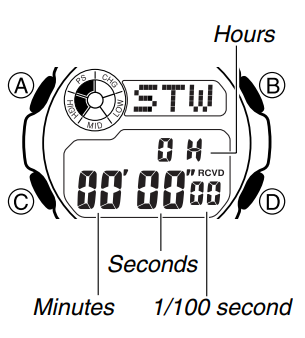
- The stopwatch lets you measure elapsed time, split times, and two finishes.
- The display range of the stopwatch is 23 hours, 59 minutes, 59.99 seconds.
- The stopwatch continues to run, restarting from zero after it reaches its limit, until you stop it.
- The stopwatch measurement operation continues even if you exit the Stopwatch Mode.
- Exiting the Stopwatch Mode while a split time is frozen on the display clears the split time and returns to elapsed time measurement.
- All of the operations in this section are performed in the Stopwatch Mode, which you enter by pressing C.
To measure times with the stopwatch
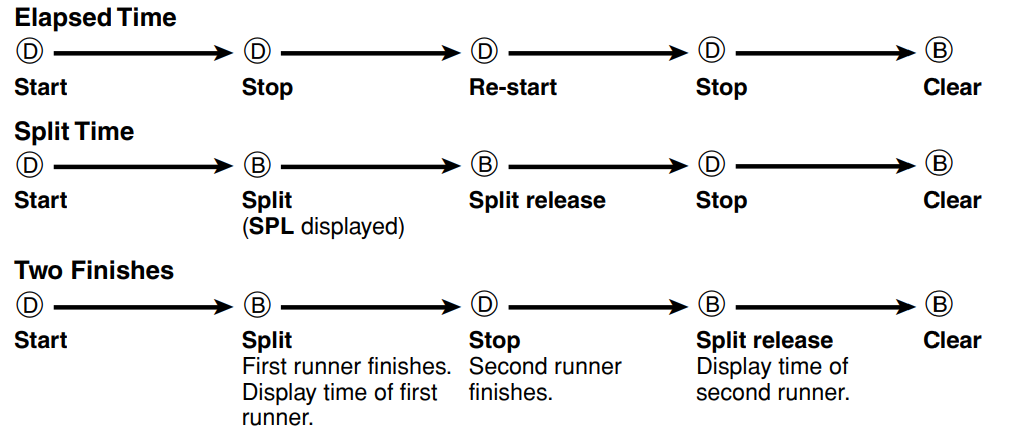
Power Supply
This watch is equipped with a solar cell and a rechargeable battery that is charged by the electrical power produced by the solar cell. The illustration shown below shows how you should position the watch for charging.
Example: Orient the watch so its face is pointing at a light source.
- The illustration shows how to position a watch with a resin band.
- Note that charging efficiency drops when any part of the solar cell is blocked by clothing, etc.
- You should try to keep the watch outside of your sleeve as much as possible. Charging is reduced significantly if the face is covered only partially.
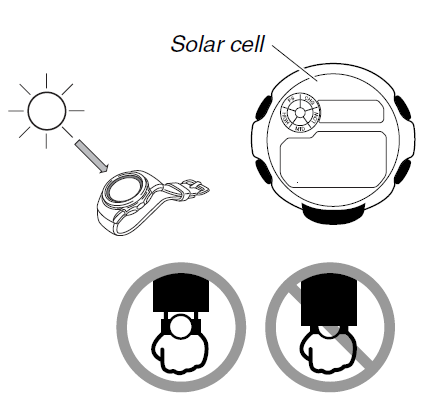
Important!
- Storing the watch for long periods in an area where there is no light or wearing it in such a way that it is blocked from exposure to light can cause rechargeable battery power to run down. Be sure that the watch is exposed to bright light whenever possible.
- This watch uses a rechargeable battery to store power produced by the solar cell, so regular battery replacement is not required. However, after very long use, the rechargeable battery may lose its ability to achieve a full charge. If you experience problems getting the rechargeable battery to charge fully, contact your dealer or CASIO distributor about having it replaced.
- Never try to remove or replace the watch’s rechargeable battery yourself. Use of the wrong type of battery can damage the watch.
- All data stored in memory is deleted, and the current time and all other settings return to their initial factory defaults whenever battery power drops to Level 5 and when you have the battery replaced
- Turn on the watch’s Power Saving function and keep it in an area normally exposed to bright light when storing it for long periods. This helps to keep the rechargeable battery from going dead.
Battery Power Indicator and Recover Indicator
The battery power indicator on the display shows you the current status of the rechargeable battery’s power.

- The flashing LOW indicator at Level 3 tells you that battery power is very low, and that exposure to bright light for charging is required as soon as possible.
- At Level 5, all functions are disabled and settings return to their initial factory defaults. Once the battery reaches Level 2 after falling to Level 5, reconfigure the current time, date, and other settings.
- The watch’s Home City code setting will change automatically to TYO (Tokyo) whenever the battery drops to Level 5. Wth this Home City code setting, the watch is configured to receive the time calibration signals of Japan. If you are using the watch in North America, Europe, or China, you will need to change the Home City code setting to match your location whenever the battery drops to Level 5.
- Display indicators reappear as soon as the battery is charged from Level 5 to Level 2.
- Leaving the watch exposed to direct sunlight or some other very strong light source can cause the battery power indicator to show a reading temporarily that is higher than the actual battery level. The correct battery level should be indicated after a few minutes
- If you use the light or alarms a number of times during a short period, all segments of the battery power indicator flash and the following operations become temporarily disabled as battery power recovers
- Display illumination
- Alarm and hourly time signal
- Time calibration signal receptio
- After some time, the battery power indicator should stop flashing to indicate that battery power is back to normal. At this time the watch should return to normal operation.
- If the battery power indicator frequently flashes, it means that battery power is low. Leave the watch in bright light to allow it to charge.
Charging Precautions
Certain charging conditions can cause the watch to become very hot. Avoid leaving the watch in the areas described below whenever charging its rechargeable battery. Also note that allowing the watch to become very hot can cause its liquid crystal display to black out. The appearance of the LCD should become normal again when the watch returns to a lower temperature.
Warning
Leaving the watch in bright light to charge its rechargeable battery can cause it to become quite hot. Take care when handling the watch to avoid burn injury. The watch can become particularly hot when exposed to the following conditions for long periods.
- On the dashboard of a car parked in direct sunlight
- Too close to an incandescent lamp
- Under direct sunlight
Charging Guide
The following table shows the amount of time the watch needs to be exposed to light each day in order to generate enough power for normal daily operations.
| Exposure Level (Brightness) | Approximate Exposure Time |
|---|---|
| Outdoor Sunlight (50,000 lux) | 5 minutes |
| Sunlight Through a Window (10,000 lux) | 24 minutes |
| Daylight Through a Window on a Cloudy Day (5,000 lux) | 48 minutes |
| Indoor Fluorescent Lighting (500 lux) | 8 hours |
- For details about the battery operating time and daily operating conditions, see the “Power Supply” section of the Specifications.
- Stable operation is promoted by frequent exposure to light.
Recovery Times
The table below shows the amount exposure that is required to take the battery from one level to the next.
| Exposure Level (Brightness) | Level 5 | Level 4 | Level 3 | Level 2 | Level 1 |
|---|---|---|---|---|---|
| Outdoor Sunlight (50,000 lux) | 2 hours | 20 hours | 6 hours | ||
| Sunlight Through a Window (10,000 lux) | 8 hours | 98 hours | 27 hours | ||
| Daylight Through a Window on a Cloudy Day (5,000 lux) | 15 hours | 200 hours | 54 hours | ||
| Indoor Fluorescent Lighting (500 lux) | 170 hours | - - - - - - | - - - - - - | - - - - - - | - - - - - - |
The above exposure time values are all for reference only. Actual required exposure times depend on lighting conditions.
Timekeeping
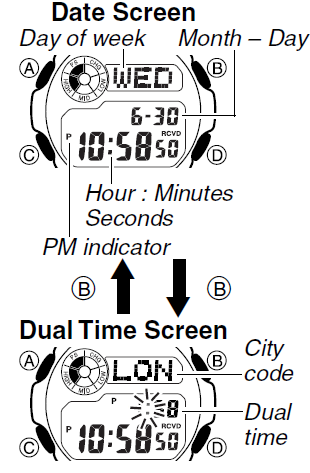
Use the Timekeeping Mode to set and view the current time and date.
- In the Timekeeping Mode, press B to toggle between the day of the week and date (Date screen), and the currently selected World Time city and time (Dual Time). Read This Before You Set the Time and Date!This watch is preset with a number of city codes, each of which represents the time zone where that city is located. When setting the time, it is important that you first select the correct city code for your Home City (the city where you normally use the watch). If your location is not included in the preset city codes, select the preset city code that is in the same time zone as your location.
- Note that all of the times for the World Time Mode city codes are displayed in accordance with the time and date settings you configure in the Timekeeping Mode.
To set the time and date manually
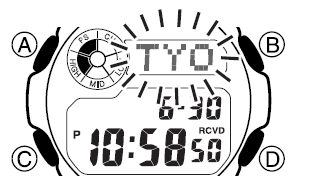
- In the Timekeeping Mode, hold down A until the city code starts to flash, which indicates the setting screen.
- Use D and B to select the city code you want.
Make sure you select your Home City code before changing any other setting.
For full information on city codes, see the “City Code Table”. Press C to move the flashing in the sequence shown below to select the other settings.

When the timekeeping setting you want to change is flashing, use D or B to change it as described below
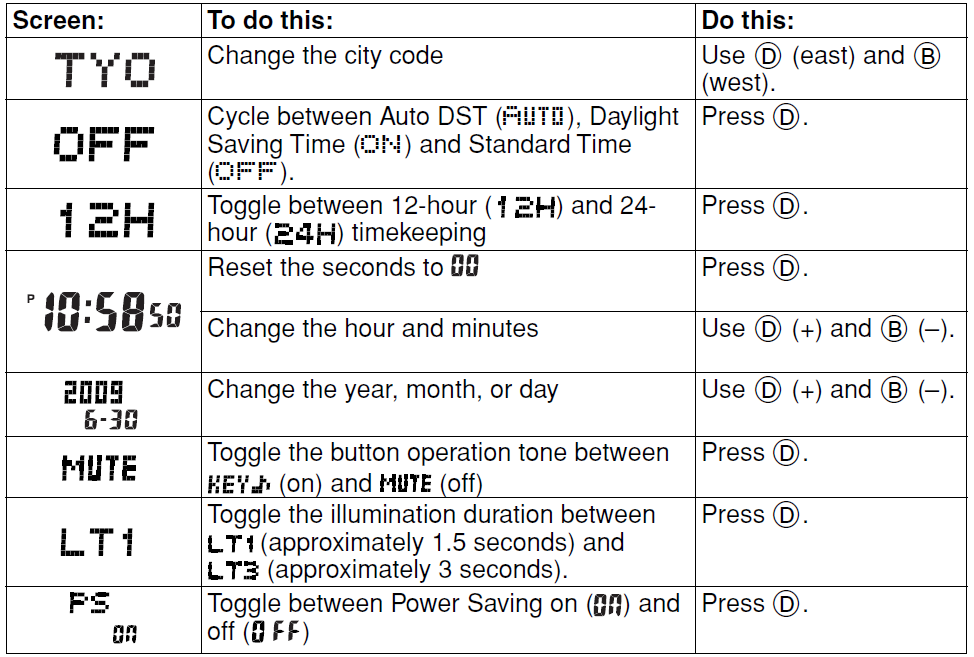
- Press A to exit the setting screen.
- Auto DST (AvtA) can be selected only while LIS, LON, MAD, PAR, ROM, BER, STO, ATH, MOW, TPE, SEL, TYO, HNL, ANC, YVR, LAX, YEA, DEN, MEX, CHI, NYC, YHZ, or YYT is selected as the Home City code. For more information, see “Daylight Saving Time (DST)”.
- The day of the week is displayed automatically in accordance with the date (year, month, and day) settings.
12-hour and 24-hour timekeeping
- With the 12-hour format, the P (PM) indicator appears to the left of the hour digits for times in the range of noon to 11:59 p.m. and no indicator appears to the left of the hour digits for times in the range of midnight to 11:59 a.m.
- With the 24-hour format, times are displayed in the range of 0:00 to 23:59, without any indicator.
- The 12-hour/24-hour timekeeping format you select in the Timekeeping Mode is applied in all other modes.
- Daylight Saving Time (DST)
- Daylight Saving Time (summer time) advances the time setting by one hour from Standard Time. Remember that not all countries or even local areas use Daylight Saving Time.
- The time calibration signals transmitted from Mainflingen (Germany), Anthorn
(England), or Fort Collins (the United States) include both Standard Time and DST data. When the Auto DST setting is turned on, the watch switches between Standard Time and DST (summer time) automatically in accordance with the signals. - Though the time calibration signals transmitted by the Fukushima and Fukuoka/Saga, Japan transmitters include summer time data, summer time currently is not implemented in Japan (as of 2008).
- The default DST setting is Auto DST (AvtA) whenever you select LIS, LON, MAD, PAR, ROM, BER, STO, ATH, MOW, TYO, ANC, YVR, LAX, YEA, DEN, MEX, CHI, NYC, YHZ, or YYT as your Home City code
- If you experience problems receiving the time calibration signal in your area, it probably is best to switch between Standard Time and Daylight Saving Time
(summer time) manually.
To change the Daylight Saving Time (summer time) setting
_setting.png)
- In the Timekeeping Mode, hold down A until the city code starts to flash, which indicates the setting screen.
- Press C and the DST setting screen appears.
Use D to cycle through the DST settings in the sequence shown below.
If you change your Home City to one that is within the same transmitter area, the current DST setting (Auto DST) will be retained. If you change to a city that is outside your current transmitter area, DST will be turned off automatically._setting_watch.png)
- When the setting you want is selected, press A to exit the setting screen.
The DST indicator appears to indicate that Daylight Saving Time is turned on.
City Code Table
| City Code | City | UTC Offset/GMT Differential |
|---|---|---|
| PPG | Pago Pago | -11 |
| HNL | Honolulu | -10 |
| ANC | Anchorage | -9 |
| YVR | Vancouver | -8 |
| LAX | Los Angeles | -7 |
| YEA | Edmonton | -7 |
| DEN | Denver | -7 |
| MEX | Mexico City | -6 |
| CHI | Chicago | -6 |
| NYC | New York | -5 |
| SCL | Santiago | -4 |
| YHZ | Halifax | -4 |
| YYT | St. Johns | -3.5 |
| RIO | Rio De Janeiro | -3 |
| FEN | Fernando de Noronha | -2 |
| RAI | Praia | -1 |
| UTC | 0 | |
| LIS | Lisbon | 0 |
| LON | London | 0 |
| MAD | Madrid | 0 |
| PAR | Paris | +1 |
| ROM | Rome | +1 |
| BER | Berlin | +1 |
| STO | Stockholm | +1 |
| ATH | Athens | +2 |
| CAI | Cairo | +2 |
| JRS | Jerusalem | +2 |
| MOW | Moscow | +3 |
| JED | Jeddah | +3 |
| THR | Tehran | +3.5 |
| DXB | Dubai | +4 |
| KBL | Kabul | +4.5 |
| KHI | Karachi | +5 |
| DEL | Delhi | +5.5 |
| KTM | Kathmandu | +5.75 |
| DAC | Dhaka | +6 |
| RGN | Yangon | +6.5 |
| BKK | Bangkok | +7 |
| SIN | Singapore | +7 |
| HKG | Hong Kong | +8 |
| BJS | Beijing | +8 |
| TPE | Taipei | +8 |
| SEL | Seoul | +9 |
| TYO | Tokyo | +9 |
| ADL | Adelaide | +9.5 |
| GUM | Guam | +10 |
| SYD | Sydney | +10 |
| NOU | Noumea | +11 |
| WLG | Wellington | +12 |
The table is a list of city codes with their corresponding cities and the UTC offset/GMT differential for each city. The data is based on information as of December 2008, and the rules governing global times (UTC offset and GMT differential) and summer time are determined by each individual country.
Troubleshooting
If the watch is not keeping accurate time, make sure that it is properly wound and that the battery is not running low. If the watch is still not keeping accurate time, try resetting it by removing the battery and then reinserting it. If the digital display is difficult to read, try adjusting the brightness of the backlight. If the watch is not responding to button presses, make sure that the battery is not completely drained and that the watch is not frozen or damaged.
| Problem | Probable Cause | What you should do |
|---|---|---|
| Cannot perform manual receive. | - The watch is not in the timekeeping mode. | - Enter the Timekeeping Mode and try again. |
| - Your current Home City is not one of the following: LIS, LON, MAD, PAR, ROM, BER, STO, ATH, MOW, HKG, BJS, TPE, SEL, TYO, HNL, | - Select LIS, LON, MAD, PAR, ROM, BER, STO, ATH, MOW, HKG, BJS, TPE, SEL, TYO, HNL, ANC, YVR, LAX, YEA, DEN, MEX, CHI, NYC, YHZ, or YYT as your Home City. | |
| ANC, YVR, LAX, YEA, DEN, MEX, CHI, NYC, YHZ, or YYT | ||
| Auto receive is turned on, but | - You changed the time setting manually. | - Perform manual signal receive or wait until the next auto signal receive operation is performed. |
| the RCVD indicator does | - The DST setting was changed manually in the World Time Mode. | - Check to make sure the watch is in a location where it can receive the signal. |
| not appear on the display. | - You pressed a button while signal receive was in progress. | |
| - Even if receive is successful, the RCVD indicator will disappear from the display each day when the first auto receive operation | ||
| of the day is performed. | ||
| - Time data (hour, minutes, seconds) only was received during the last receive operation. The RCVD indicator appears only when | ||
| time data and date data (year, month, day) are both received. | ||
| Time setting is incorrect | - If the time is one hour off, the DST setting may be incorrect. | - Change the DST setting to Auto DST. |
| following signal reception. | - The Home City Code setting is not correct for the area where you are using the watch. | - Select the correct Home City code. |
Pros & Cons of G-Shock 3195
Pros
- Rugged and durable design
- Water-resistant up to 200 meters
- Digital display is easy to read
- Various functions, such as stopwatch, countdown timer, and multiple alarms
- World time function for travelers
Cons
- May be too large for some wrists
- Digital display may be difficult to read in bright sunlight
- Battery life may be shorter than other watches due to the use of a quartz movement
Faqs
What should I do if my Casio G-Shock 3195's display is dim or blank?
How can I turn on and utilise the Casio G-Shock 3195's alarm feature?
With my Casio G-Shock 3195 Digital Watch, can I take a shower or go swimming?
Is it possible to change the band on my Casio G-Shock 3195, and if so, where can I get new ones?
How can I fix my Casio G-Shock 3195's broken backlight? Why is it not working?
What kind of battery is needed for my Casio G-Shock 3195, and how do I change it?
What are the Casio G-Shock 3195's world time features, and how can I use them?
How do I mute the buttons on my Casio G-Shock 3195 and change the sound settings?
If the buttons on my Casio G-Shock 3195 are not working, what should I do?
What is covered by the warranty that comes with the Casio G-Shock 3195?
Leave a Comment
